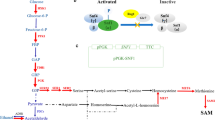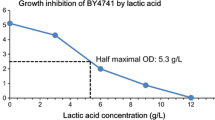Abstract
Ribonucleic acid (RNA) and its degradation products are widely used in the food industry. In this study, we constructed Saccharomyces cerevisiae mutants with FHL1, IFH1, SSF1, and SSF2 overexpression and HRP1 deletion, individually to evaluate the effect on RNA production. The RNA content of recombinant strains W303-1a-FHL1, W303-1a-SSF2, and W303-1a-ΔHRP1 was increased by 14.94%, 24.4%, and 19.36%, respectively, compared with the RNA content of the parent strain. However, W303-1a-IFH1 and W303-1a-SSF1 showed no significant change in RNA production compared with the parent strain. IFH1 and FHL1 encode Ifh1p and Fhl1p, respectively, which combine to form a complex that plays a key role in the transcription of the ribosomal protein (RP) gene. Ssf2p, encoded by SSF2, plays an important role in ribosome biosynthesis and Hrp1p is a negative regulator of cell growth in S. cerevisiae. Subsequently, a high RNA production strain, W112, was constructed by simultaneously overexpressing FHL1, IFH1, and SSF2 and deleting HRP1. The RNA content of W112 was 38.8% higher than the parent strain. The growth performance, RP transcription levels, and rRNA content were also investigated in the recombinant strains. This study provides a new strategy for the construction of S. cerevisiae strains containing large amounts of RNA, and it will make a significant contribution to progress in the nucleic acid industry.
Key Points
• Simultaneously overexpressing FHL1, IFH1, and SSF2 and deleting HRP1 can significantly increases RNA production.
• The production of RNA increased by 38.8% in Saccharomyces cerevisiae.
• The cell size and growth rate of the strains with higher RNA content also increased.






Similar content being viewed by others
References
Barbalat R, Ewald SE, Mouchess ML, Barton GM (2011) Nucleic acid recognition by the innate immune system. Annu Rev Immunol 29:185–214
Bogengruber E, Briza P, Doppler E, Wimmer H, Koller L, Fasiolo F, Senger B, Hegemann HJ, Breitenbach M (2003) Functional analysis in yeast of the Brix protein superfamily involved in the biogenesis of ribosomes. FEMS Yeast Res 3:35–43
Causton HC, Ren B, Koh SS, Harbison CT, Kanin E, Jennings EG, Lee TI, True HL, Lander ES, Young RA (2001) Remodeling of yeast genome expression in response to environmental changes. Mol Biol Cell 12:323–337
Cherel I, Thuriaux P (1995) The IFH1 gene product interacts with a fork head protein in Saccharomyces cerevisae. Yeast 11:261–270
Chuwattanakul V, Kim Y, Sugiyama M, Nishiuchi H, Miwa H, Kaneko Y, Harashima S (2011) Construction of a Saccharomyces cerevisiae strain with a high level of RNA. J Biosci Bioeng 112:1–7
Denmat HL, Werner M, Sentenac A, Thuriaux P (1994) Suppression of yeast RNA polymerase III mutations by FHL1, a gene coding for a fork head protein involved in rRNA processing. Mol Cell Biol 14:2905–2913
Durocher D, Jackson SP (2002) The FHA domain. FEBS Lett 513(1):58–66
Ewald BM, Denner TJ, Mcgenity HJ, William B (1994) Halococcus salifodinae sp. nov., an archaeal isolate from an Austrian salt mine. Int J Syst Evol 44:774–780
Gueldener U, Heinisch J, Koehler GJ, Voss D, Hegemann JH (2002) A second set of loxP marker cassettes for Cre-mediated multiple gene knockouts in budding yeast. Nucleic Acids Res 30:e23
Holzschu DL, Chandler FW, Ajello L, Ahearn DG (1979) Evaluation of industrial yeasts for pathogenicity. Sabouraudia 17:71–78
Jae YE, Jin YH, Kyu JY, Pernilla B, Mohammad T, Hong SH, Karl E, Dai PS (2000) Fission yeast Hrp1, a chromodomain ATPase, is required for proper chromosome segregation and its overexpression interferes with chromatin condensation. Nucleic Acids Res 28:2004–2011
Jin YH, Yoo EJ, Jang KY, Kim SH, Kim MJ, Shim YS, Lee JS, Choi IS, Seong RH, Hong SH, Park SD (1998) Isolation and characterization of hrp1+, a new member of the SNF2/SWI2 gene family from the fission yeast Schizosaccharomyces pombe. Mol Gen Genet 257:319–329
Khatun F, Kurata K, Chuwattanakul V, Sugiyama M, Kaneko Y, Harashima S (2013a) Increased transcription of RPL40A and RPL40B is important for the improvement of RNA production in Saccharomyces cerevisiae. J Biosci Bioeng 116:423–432
Khatun F, Sasano Y, Sugiyama M, Kaneko Y, Harashima S (2013b) Increase in rRNA content in a Saccharomyces cerevisiae suppressor strain from rrn10 disruptant by rDNA cluster duplication. Appl Microbiol Biotechnol 97:9011–9019
Kief DR, Warner JR (1981) Coordinate control of syntheses of ribosomal ribonucleic acid and ribosomal proteins during nutritional shift-up in Saccharomyces cerevisiae. Mol Cell Biol 1:1007–1015
Kim MS, Hahn JS (2016) Role of CK2-dependent phosphorylation of Ifh1 and Crf1 in transcriptional regulation of ribosomal protein genes in Saccharomyces cerevisiae. Biochim Biophys Acta 1859:1004–1013
Kurihara K, Kashiwayanagi M (2000) Physiological studies on umami taste. J Nutr 130:931S–934S
Lee TI, Rinaldi NJ, Robert F, Odom DT, Bar-Joseph Z, Gerber GK, Hannett NM, Harbison CT, Thompson CM, Simon I, Zeitlinger J, Jennings EG, Murray HL, Gordon DB, Ren B, Wyrick JJ, Tagne JB, Volkert TL, Fraenkel E, Gifford D, Young RA (2002) Transcriptional regulatory networks in Saccharomyces cerevisiae. Sci 298:799–804
Li P, Gao YY, Wang CL, Zhang CY, Guo XW (2018) Effect of ILV6 deletion and expression of aldB from Lactobacillus plantarum in Saccharomyces uvarum on diacetyl production and wine flavor. J Agric Food Chem 66:8556–8565
Lilly M, Lambrechts MG, Pretorius IS (2000) Effect of increased yeast alcohol acetyltransferase activity on flavor profiles of wine and distillates. Appl Environ Microbiol 66:744–753
Lu SC, Mato JM (2008) S-Adenosylmethionine in cell growth, apoptosis and liver cancer. J Gastroenterol Hepatol 23:S73–S77
Mallick J, Whiteway M (2013) The evolutionary rewiring of the ribosomal protein transcription pathway modifies the interaction of transcription factor heteromer Ifh1-Fhl1 (interacts with Forkhead 1-Forkhead-like 1) with the DNA-binding specificity element. J Biol Chem 288:17508–17519
Nagodawithana T (1992) Yeast-derived flavors and flavor enhancers and their probable mode of action. Food Technol 46:138–144
Pelechano V, Chávez S, Pérez-Ortín JE (2010) A complete set of nascent transcription rates for yeast genes. PLoS One 5:e15442
Regenberg B, Grotkjær T, Winther O, Fausbøll A, Åkesson M, Bro C, Hansen LK, Branuk S, Nielsen S (2006) Growth rate regulated genes have profound impact on interpretation of transcriptome profiling in Saccharomyces cerevisiae. Genome Biol 7:1–13
Rudra D, Zhao Y, Warner JR (2005) Central role of Ifh1p-Fhl1p interaction in the synthesis of yeast ribosomal proteins. EMBO 24:533–542
Sasano Y, Kariya T, Usugi S, Sugiyama M, Harashima S (2017) Molecular breeding of Saccharomyces cerevisiae with high RNA content by harnessing essential ribosomal RNA transcription regulator. AMB Express 7:32
Shao Z, Zhao H, Zhao H (2009) DNA assembler, an in vivo genetic method for rapid construction of biochemical pathways. Nucleic Acids Res 37:e16
Waititu SM, Heo JM, Patterso R, Nyachoti CM (2016) Dietary yeast-based nucleotides as an alternative to in-feed antibiotics in promoting growth performance and nutrient utilization in weaned pigs. Can J Anim Sci 96:289–293
Waldron C, Lacroute FJ (1975) Effect of growth rate on the amount of ribosomal and transfer ribonucleic acids in yeast. J Bacteriol 122:855–865
Warner JR (1999) The economics of ribosome biosynthesis in yeast. Trends Biochem Sci 24:437–440
Wehner KA, Baserga SJ (2002) The σ70-like motif: A eukaryotic RNA binding domain unique to a superfamily of proteins required for ribosome biogenesis. Mol Cell 9:329–339
Yan Y, Hirsch JP (1995) An essential gene pair in Saccharomyces cerevisiae with a potential role in mating. DNA Cell Biol 14:411–418
Yi, Kevin L,Tian L, Stewart S (2000) Characterization of Candida albicans RNA triphosphatase and mutational analysis of its active site. Nucleic Acids Res 28:1885–1892
Funding
This work was supported by the National Natural Science Foundation of China (No. 31671834), the National Key Research and Development Program of China (No. 2016YFD0400505), the China Postdoctoral Science Foundation (2017M611169), the Hebei Province Postdoctoral Research Projects (No. B2018003031), and the Public Service Platform Project for Selection and Fermentation Technology of Industrial Microorganisms (No. 17PTGCCX00190)
Author information
Authors and Affiliations
Contributions
XWG conceived and designed the research. BZ and XRZ conducted experiments. XFN, DXL, and TLC contributed new reagents or analytical tools. XWG, YFC, and DGX analyzed the data. XWG wrote the manuscript. All authors read and approved the manuscript.
Corresponding author
Ethics declarations
Conflict of interest
The authors declare that they have no conflict of financial interest.
Ethical approval
This article does not contain any studies with human participants or animals performed by any of the authors.
Additional information
Publisher’s note
Springer Nature remains neutral with regard to jurisdictional claims in published maps and institutional affiliations.
Rights and permissions
About this article
Cite this article
Guo, X., Zhao, B., Zhou, X. et al. Increased RNA production in Saccharomyces cerevisiae by simultaneously overexpressing FHL1, IFH1, and SSF2 and deleting HRP1. Appl Microbiol Biotechnol 104, 7901–7913 (2020). https://doi.org/10.1007/s00253-020-10784-9
Received:
Revised:
Accepted:
Published:
Issue Date:
DOI: https://doi.org/10.1007/s00253-020-10784-9




